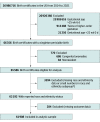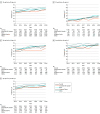Trends in Active Treatment of Live-born Neonates Between 22 Weeks 0 Days and 25 Weeks 6 Days by Gestational Age and Maternal Race and Ethnicity in the US, 2014 to 2020
- PMID: 35972487
- PMCID: PMC9382444
- DOI: 10.1001/jama.2022.12841
Trends in Active Treatment of Live-born Neonates Between 22 Weeks 0 Days and 25 Weeks 6 Days by Gestational Age and Maternal Race and Ethnicity in the US, 2014 to 2020
Abstract
Importance: Birth in the periviable period between 22 weeks 0 days and 25 weeks 6 days' gestation is a major source of neonatal morbidity and mortality, and the decision to initiate active life-saving treatment is challenging.
Objective: To assess whether the frequency of active treatment among live-born neonates in the periviable period has changed over time and whether active treatment differed by gestational age at birth and race and ethnicity.
Design, setting, and participants: Serial cross-sectional descriptive study using National Center for Health Statistics natality data from 2014 to 2020 for 61 908 singleton live births without clinical anomalies between 22 weeks 0 days and 25 weeks 6 days in the US.
Exposures: Year of delivery, gestational age at birth, and race and ethnicity of the pregnant individual, stratified as non-Hispanic Asian/Pacific Islander, non-Hispanic Black, Hispanic/Latina, and non-Hispanic White.
Main outcomes and measures: Active treatment, determined by whether there was an attempt to treat the neonate and defined as a composite of surfactant therapy, immediate assisted ventilation at birth, assisted ventilation more than 6 hours in duration, and/or antibiotic therapy. Frequencies, mean annual percent change (APC), and adjusted risk ratios (aRRs) were estimated.
Results: Of 26 986 716 live births, 61 908 (0.2%) were periviable live births included in this study: 5% were Asian/Pacific Islander, 37% Black, 24% Hispanic, and 34% White; and 14% were born at 22 weeks, 21% at 23 weeks, 30% at 24 weeks, and 34% at 25 weeks. Fifty-two percent of neonates received active treatment. From 2014 to 2020, the overall frequency (mean APC per year) of active treatment increased significantly (3.9% [95% CI, 3.0% to 4.9%]), as well as among all racial and ethnic subgroups (Asian/Pacific Islander: 3.4% [95% CI, 0.8% to 6.0%]); Black: 4.7% [95% CI, 3.4% to 5.9%]; Hispanic: 4.7% [95% CI, 3.4% to 5.9%]; and White: 3.1% [95% CI, 1.1% to 4.4%]) and among each gestational age range (22 weeks: 14.4% [95% CI, 11.1% to 17.7%] and 25 weeks: 2.9% [95% CI, 1.5% to 4.2%]). Compared with neonates born to White individuals (57.0%), neonates born to Asian/Pacific Islander (46.2%; risk difference [RD], -10.81 [95% CI, -12.75 to -8.88]; aRR, 0.82 [95% CI, [0.79-0.86]), Black (51.6%; RD, -5.42 [95% CI, -6.36 to -4.50]; aRR, 0.90 [95% CI, 0.89 to 0.92]), and Hispanic (48.0%; RD, -9.03 [95% CI, -10.07 to -7.99]; aRR, 0.83 [95% CI, 0.81 to 0.85]) individuals were significantly less likely to receive active treatment.
Conclusions and relevance: From 2014 to 2020 in the US, the frequency of active treatment among neonates born alive between 22 weeks 0 days and 25 weeks 6 days significantly increased, and there were differences in rates of active treatment by race and ethnicity.
Conflict of interest statement
Figures



Comment in
-
Active Treatment and Shared Decision-making for Infants Born Extremely Preterm at 22 to 25 Weeks.JAMA. 2022 Aug 16;328(7):624-626. doi: 10.1001/jama.2022.13364. JAMA. 2022. PMID: 35972504 No abstract available.
References
-
- Hamilton BE, Martin JA, Osterman MJ, Curtin SC, Matthews TJ. Births: final data for 2014. Natl Vital Stat Rep. 2015;64(12):1-64. - PubMed
MeSH terms
Grants and funding
LinkOut - more resources
Full Text Sources
Medical
Miscellaneous

